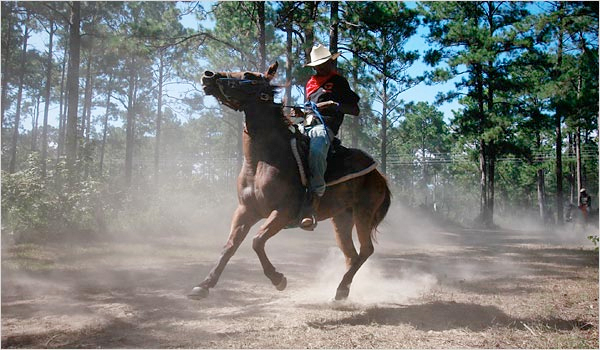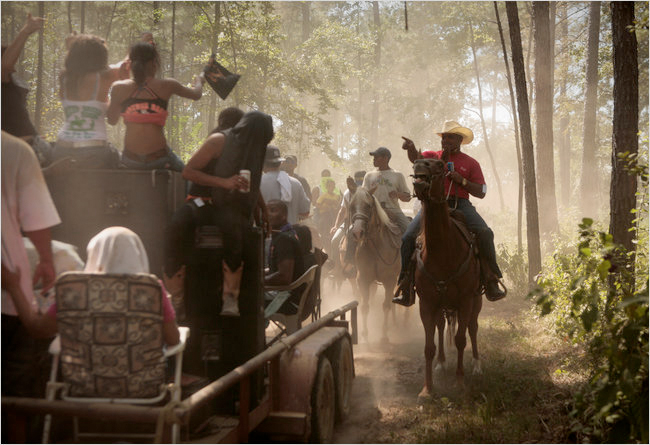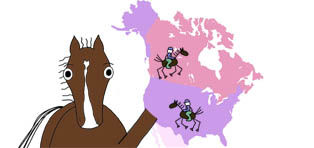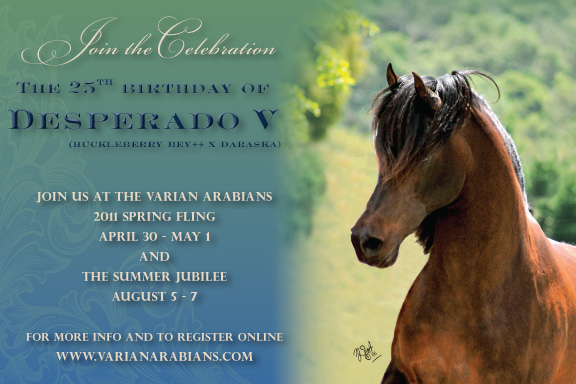
photo:The Pineywoods Trail Ride, held in Beaver, La., last Labor Day weekend, is one of a circuit of zydeco trail rides that take place in Cajun country around Lafayette, La., and in parts of Texas.
New York Times
By SHAILA DEWAN
Published: April 22, 2011
I HAD never noticed how closely the syncopated rhythm of zydeco music echoes the rollicking stumble of horses on rough terrain. But on a September afternoon in the piney woods of Evangeline Parish, in Louisiana’s Cajun country, with hundreds of dusty horseback riders moving down a narrow trail, the kinship was impossible to miss. As the horses followed a tractor towing a D.J. and a zydeco-blaring sound system, they bucked and swayed in a cadence fit for the barroom floors of Lafayette, 70 miles away.
Eventually the riders — young and old, encumbered by cold beers or small children — reached a large clearing in the middle of the woods, which quickly filled with horses, flatbeds, wagons and buggies as the music continued to throb. People sold barbecue sandwiches and turkey legs from the backs of pick-up trucks. A group of women piled out of a wagon and serenely performed a line dance in the dust. Young people sang and flirted and held up their beers with a “Wooo!”
The clearing was the halfway point of the Pineywoods Trail Ride, one of a circuit of zydeco trail rides that take place in the countryside around Lafayette and in many parts of Texas from Mardi Gras through early December. Exuberant, untouched by corporate sponsors and run by a close-knit network of people who price their beer at $2 a can, the rides are a traditional way to celebrate the cowboy culture of rural blacks or Creoles (commonly understood as a mixture of black with French, Spanish and/or Native American ancestry).
Originally small affairs among relatives and neighbors, the rides have evolved over decades into organized events with a dedicated following, though they have remained largely unknown to outsiders. In recent years, trail rides have surged in popularity among rural youth, as zydeco musicians have incorporated strains of R&B and hip-hop, attracting a new generation for whom Creole is suddenly cool.
The Pineywoods ride, for which more than 2,000 people gathered over the course of three days, started and ended on a farm with an open-sided pavilion that, by the end, would be in a sorry shambles — its benches broken from the weight of people climbing up to get a look at the musicians, an industrial-size Dumpster outside overflowing with the detritus of revelry. It would be a huge, weird, miles-from-nowhere party, one that I had fantasized about for nearly five years.
IN July 2006, when my friend Lisa D’Amour and I embarked on a long, music-seeking weekend with Lafayette as our base, all we knew about zydeco trail rides had been gleaned from an endearingly amateurish Louisiana music fan site: they existed, they took place regularly on Sundays somewhere in the area and to find one, you might try listening to the local Cajun radio program. There was no mention of the fact that the program was in French.
Neither a more extensive Internet search nor the local newspapers got us any further. But the more elusive zydeco trail rides seemed, the more important it became to find one, even if it meant wasting an entire day.
We began our search with an inquiry at Prejean’s, a Cajun restaurant in Lafayette with a stuffed alligator in the entryway and a Webcam that provides worldwide access to views of tourists enjoying shrimp sassafras. Stupid questions are not a rarity at Prejean’s, but our waiter was stumped. Finally, he suggested we take a half-hour drive to Lawtell, the home of iconic zydeco clubs like the Offshore Lounge.
Lafayette is a small city, and you don’t have to go far in any direction before things turn very country, as in gas-station boudin and music venues that are open only on Saturday mornings. Travel south or east, and you will soon see signs for swamp tours; go north, toward Lawtell and Opelousas, and it’s scrub, forest and farms. We knew we had arrived when we saw a hand-painted sign: “Welcome to Lawtell, Home of the Town and Country Riders.” We found an old store that sold bait and rusty key chains, but when we mentioned trail rides, the white man behind the counter gave us a blank look.
At another gas station, a black cashier was more helpful, pointing us to an inebriated man buying a Sunday morning case of beer, who kindly led us to a large shade tree where a man was shoeing a horse. Several other men were hanging around, one of whom wore a rodeo championship belt buckle as big as a chicken-fried steak. Lisa and I looked at each other and grinned.
These men, we soon learned, were not the Lawtell Town and Country Riders, now defunct, but a different club, the Lawtell Low Riders. And yes, they could take us to a trail ride.
The riding clubs, we came to understand, are a fixture of life in Acadiana, the part of southern Louisiana named for the exiled French Canadians who settled it. Here, even Mardi Gras is traditionally celebrated on horseback; the riders are masked. The clubs are a formalization of the loose confederacies that developed among rural African-Americans out of kinship, friendship or necessity. The rides themselves have their roots in country traditions like boucheries, or hog butcherings.
 Nowadays the clubs form the organizational core of the zydeco trail rides, competing to attract the most riders and hire the best bands and D.J.’s. Die-hard riders will bring their horses out every weekend, even if it means towing them across state lines, but most rides remain obscure to outsiders. Even a popular one like the Step-N-Strut, held in St. Landry Parish in early November, which has evolved into a multiday music festival that attracts thousands of people, is still not well known outside the circuit.
Nowadays the clubs form the organizational core of the zydeco trail rides, competing to attract the most riders and hire the best bands and D.J.’s. Die-hard riders will bring their horses out every weekend, even if it means towing them across state lines, but most rides remain obscure to outsiders. Even a popular one like the Step-N-Strut, held in St. Landry Parish in early November, which has evolved into a multiday music festival that attracts thousands of people, is still not well known outside the circuit.The clubs strive to set their rides apart — Pineywoods, for example, is known for using an actual trail instead of backcountry roads. But they do have certain things in common: each begins and ends at a church, community center or private parcel of land, sometimes with a pavilion built for dancing.
Our new friend the horseshoe man, whose name was Paul Young, disappeared for a good while and returned with his family (son Paul and daughter Paula) and a trailer full of horses. First we followed him in one direction, seeing nothing but farmland and fishing holes. Then he turned around and went the other direction for an even longer ride. Later it was explained that he had changed plans after learning that the first ride had been canceled, but the detour gave Lisa and me ample time to consider what we were doing: following a bunch of men we had just met across two parishes to the middle of nowhere. Just as a sense of doom was sinking in, we pulled off onto a dirt road, passed a chicken coop and saw three runaway horses with men in pursuit. A guy stationed at the gate collected $5 a head as we passed.
The trail ride had already begun, so there was a scramble to saddle up the horses. Soon, we were headed down a country road at a fast clip. It was hot, and someone reached into a saddlebag and handed me a Coors Light, which bubbled over and spattered on the ground as I tried to drink and ride one-handed. (Note: saddles are not equipped with cup holders.)
Soon we caught up to the other riders: at least a couple hundred people on horseback; a horse-drawn buggy with red wheels and black tufted upholstery; and a wagon or two loaded up with coolers and people. (One flatbed trailer carried a portable toilet.) In the middle of it all was an old, slowly coasting yellow and white truck with a rabbit painted on the side, outfitted front and back with speakers, out of which issued the familiar canter of zydeco. Lisa and I were as awed as if we had unwittingly stumbled across Burning Man while trekking in the Black Rock Desert.
We had spent the previous two days hearing music in the area, and had begun to grasp the differences between the two kinds of music that are essential to the identity of Acadiana. Cajun music, a mournful back porch music of waltzes and fiddles, is still largely the province of white musicians. Zydeco, a more upbeat, catchy genre, is played mostly by blacks. It uses the accordion and washboard, more often called a scrub-board, and went mainstream in the mid-1980s with the help of the hit song “My Toot Toot” and the Dennis Quaid movie “The Big Easy.”
Perhaps because of the movie, many people associate zydeco with New Orleans. But zydeco is country music, created by Creole cowboys. The zydeco rides in Texas are a direct result of pollination by Louisiana Creoles, who went there to do seasonal farm work and brought the music along.
Much later, as my interest in trail rides grew keener, I called the owner of the yellow truck, Frank Malbrough Jr., at his home in Church Point, La. (he was watching a home video of a trail ride when the phone rang). Mr. Malbrough, 79, is known as the Breadman because of his truck’s former service at a Bunny Bread bakery. He claims to have attended a ride every weekend of the season since 1985.
“Trail rides used to be a neighbor thing,” he said. “I got a horse, you got a horse — these guys worked on horseback in the rice harvesting. They started mixing with that horse on Sundays, then they would meet and ride in the woods and have a good time. Trail riding became a family affair.”
There is no telling, according to this history, when the first zydeco trail ride officially occurred. But the rides ended, as they do now, in music and dancing, at a church or on someone’s porch. The Breadman takes credit for the innovation of bringing the music along on the ride itself, first with a borrowed boombox and later with the Bread Truck, purchased in the mid-1980s.
After several hours of following the Bread Truck, we all returned to the farm where we started. Under the shelter of what seemed like a picnic pavilion at a public park, a zydeco band played through a late afternoon rainstorm, and everybody danced. The ride, and all that went with it, encapsulated everything we loved about Louisiana, whose most inviolable traditions are built around enjoyment and leisure; where proud strangers will lend you a horse and hand you a cold beer not because they have a reputation of hospitality to uphold but because it would be a blot on their honor if you did not have fun; and where things coalesce not because of anything you or I might recognize as organization, but according to their own internal logic. With a little luck we had been welcomed into an afternoon of unmediated Creole culture. This was the side of Louisiana that anthropologists love to study, but I love to visit.
JOE FONTENOT, 65, was famous in his youth for riding a pet bull. He can remember capturing wild horses by dropping from a tree onto their backs. On his farm, he raises horses, naked-neck chickens and the guinea hens he says make for better gumbo.
Driving from Lafayette late on a Friday evening last September, I found the Fontenot farm by following cardboard signs that pointed the way. Ever since that first ride, I had wanted to attend another, but had not really known where to start. When I Googled “zydeco trail ride,” I found a forum whose most recent post was two years old, some YouTube videos of trail rides past and a 1989 album by Boozoo Chavis, the zydeco star. Frustrating as it may be to interested outsiders, riding clubs still rely primarily on a tried-and-true advertising method: distributing fliers to trail riders at trail rides.
I made some calls and finally got in touch with Torry Lemelle, who runs the Step-N-Strut and whose husband, Dave, is the president of Border2Border, one of two main Louisiana riding club associations. She told me that the Pineywoods ride, held in Beaver, La., on Labor Day weekend, had been run by the Fontenot family for 25 years, and gave me a number to call. Ultimately this led me to the farm’s gate, where I leaned out my car window and paid $20 for a weekend pass.
I had been delayed by a hurricane on the East Coast, so spent part of the evening nursing my disappointment that I had missed the free supper of cochon de lait — marinated suckling pig that had roasted all day in a metal box, or a “Cajun microwave,” as the Fontenots call it.
At first, the feel was a lot like that of the 2006 ride — the farm, the dance pavilion (where at least seven varieties of Boone’s Farm wine were on offer), the RVs and horse trailers lining the grounds in a vast encampment. There would be live bands all three nights, and I watched as the serious dancers took advantage of the one night when the floor would not be overcrowded. A determined young woman chomped her gum in time to JoJo Reed and the Happy Hill Band as she and her partner covered great swaths of dance floor, never pausing for breath.
On Saturday morning, adults hunched over domino games or tended to the ribs, gumbo or backbone stew they were cooking at their campsites, while children played and rode bareback. But as cars and campers steadily poured into the grounds, an influx that would continue right up to the start of the main trail ride on Sunday, the place took on a different feel. At my first ride, I had noticed a lot of old-timers — “originals,” they call themselves — wearing, as Joe Fontenot did, pressed Western shirts and string ties.
But at the Pineywoods ride, as more and more young people crowded the grounds, I noticed cargo shorts and rubber-soled boots with brightly colored uppers, some with an accumulation of paper wristbands from previous rides threaded through the pull straps in a display of trail ride status.
Virtually everyone wore T-shirts proclaiming their allegiance to a particular riding club: the No Limit Riders of Mamou, La., the Spare Time Riders of New Roads, the Hip Hop Ghetto Riders of Breaux Bridge. Some clubs, like the Exclusive Steppers, showed loyalty to a particular kind of mount, the high-stepping Tennessee walker, considered the Cadillac of trail riding (“If you ain’t steppin’, you ain’t reppin’ ”). Others, like the Wild Bird Riders, honored their favorite whiskey, while the Suga Riders were named in memory of “one of the realest cowboys you would ever get to know,” a Lafayette man who rode his horse to nightclubs. The Mixed Breed Riders, a youthful posse in short-shorts and tank tops, gave a nod to the racial mélange so common in Acadiana. I counted upward of 50 riding clubs, though a few of them didn’t seem to bother with actual horses.
I also heard, between bands, the D.J.’s play something I hadn’t heard at the earlier ride: the occasional hip-hop track (Lil Boosie, a Baton Rouge rapper, was a favorite). In fact, several attendees credited the surge in popularity of the rides to zydeco musicians like Brian Jack and Chris Ardoin, who have given the music a more contemporary feel. On Saturday night, Brian Jack would pack the pavilion, getting a loud cheer when he asked, “How many cowgirls you got out there?”
I met Arloe Fontenot, a 32-year-old member of the extended Fontenot clan, whose members, many of whom have green eyes, range in appearance from fair to dark. “When we were young, we fell into a middle ground in terms of race,” Arloe said. He added, good-naturedly, “Now everyone wants to be Creole, meaning everyone wants to have some freaking boots on and play zydeco in their car and go to one trail ride and call themselves Creole.” This yearning apparently applies to whites as well — I noticed a more racially diverse crowd than I had in 2006, when Lisa and I were the only nonblacks in attendance.
Daphne Rideaux, a 22-year-old member of the Mixed Breed Riders, told me that all any newcomer needs is “the boots, the belt, the spurs and the trail rider shirt,” adding, “They can make their own.” (Park Slope Steppers, are you reppin’?)
From a food truck, I bought a dozen tamales, made by Mr. Fontenot’s sister-in-law and served with saltine crackers and hot sauce, for $8. As I strolled the grounds, I met mail carriers and pipe fitters, a man called Mule who made extra money shoeing horses, and a bank teller named Angela Deculus, who patiently taught me the basic zydeco dance step. Zydeco dancers swear this step is all you need to know, but I have learned it countless times, only to be boot-scooted right off the floor. Figuring out what people are doing with their feet when they zydeco is like trying to determine whether all of a horse’s hooves leave the ground as it gallops.
But I still love to watch, especially the people who grew up dancing in this music-steeped culture. The older couples meld as if they had been specially machined to perform in unison; the younger couples clasp hands as they move one way, only to drop them on the return with inimitable insouciance. You can almost see the church halls, the linoleum floors, the lessons from grandpa, the generations that precede each particular dance — see the music moving through the blood. These dancers zydeco the way they sit a horse.
On Saturday afternoon, there was a “mini-ride,” or what Mr. Fontenot called a “vice-versa ride” because it follows the route of the big Sunday ride in reverse.
It was quieter than the Sunday ride would be, and together several hundred of us passed through woods filled with bright purple beautyberries. The temperature hovered at an amazingly cool 80 degrees. Mr. Fontenot no longer rides, but his grandson Casey, then 9, took the lead position, slung across his horse at a jaunty tilt, just as if he had been born up there and it had never occurred to him to get down.
SADDLE UP AND PASS THE BOUDIN
FINDING A TRAIL RIDE
Zydeco trail rides take place primarily in Louisiana and Texas.
Two of the biggest zydeco trail ride associations in Louisiana, which serve as umbrella groups for the clubs, are the Border2Border Trail Ride Association and the Rainbow Trail Ride Association, both of which include Texas rides on their calendars.
Their 2011 schedules are posted at billpickettrailriders.com and marcsobers.com. There are a lot of T.B.A.’s on those schedules, but I found updated information for rides in the next couple of months at zydecoevents.com/trailriders.
In Louisiana, the ride itself is held on Sunday; in Texas, it is often on Saturday with a rodeo on Sunday (and Louisiana folk will tell you that the food is not as good). If you do not have a horse, you can ride on a wagon; often at least one of these belongs to the ride organizers. Let them know you are a first-timer.
SLEEPING AND EATING
To camp at a trail ride, you will likely need a camper or RV — there are generally no facilities for tent camping. Otherwise, you can find a hotel close to your chosen ride’s location; there are accommodations in Opelousas, Eunice, Ville Platte and Breaux Bridge (where the Café des Amis is known for its zydeco brunch on Saturdays). Lafayette is a good base from which to explore the trail riding scene, but expect to drive an hour or more to get to one from there.
In Lafayette the Blue Moon Saloon (215 East Convent Street; 877-766-2583; bluemoonpresents.com), has a guest house catering to music lovers. Rooms start at $70; “dorm” rooms that sleep up to eight are $18 a person.
Prejean’s (3480 Northeast Evangeline Thruway; 337-896-3247; prejeans.com), is open for breakfast, lunch and dinner,
Ask the locals which gas station has the best boudin.





 photo: Juleen Feazell and Sixes Peppy Lady
photo: Juleen Feazell and Sixes Peppy Lady photo: Judy Mason and Cedar Mesa Rushai
photo: Judy Mason and Cedar Mesa Rushai photo: Brandy Ferganchick and Fawn Creek Thor
photo: Brandy Ferganchick and Fawn Creek Thor


 America's wild horses have long been praised by their owners for their toughness, intelligence and endurance.
America's wild horses have long been praised by their owners for their toughness, intelligence and endurance. Sir Kai, currently ridden by Lincoln's Ray Bailey, also was originally adopted by Dr. Ottinger. Bailey acquired the titled three-year-old from Dr. Ottinger in 1997. Sir Kai placed ninth in his first limited-distance ride, the "Death Valley 25," in 1999. He followed that performance with a third place and best condition award in the Lake Oroville Vista LD ride. During the 2003 AERC National Championship Ride, Sir Kai and Bailey placed first in the heavyweight division of the 50-mile ride.
Sir Kai, currently ridden by Lincoln's Ray Bailey, also was originally adopted by Dr. Ottinger. Bailey acquired the titled three-year-old from Dr. Ottinger in 1997. Sir Kai placed ninth in his first limited-distance ride, the "Death Valley 25," in 1999. He followed that performance with a third place and best condition award in the Lake Oroville Vista LD ride. During the 2003 AERC National Championship Ride, Sir Kai and Bailey placed first in the heavyweight division of the 50-mile ride.
.jpg)
.jpg)
